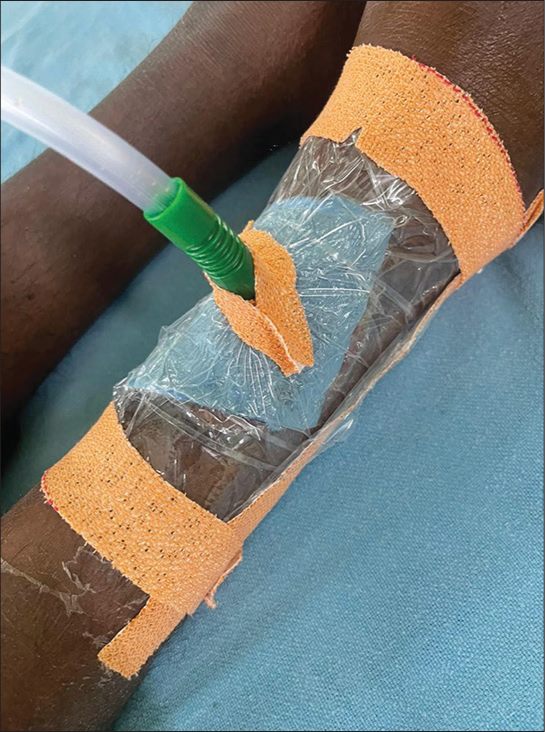Translate this page into:
Surgical pearl: Vacuum-assisted closure: A cost-effective technique
*Corresponding author: Shreya K, Department of Dermatology and Venereology, AIIMS, Habibganj, Saketnagar, Bhopal, India. shreyakgowda@gmail.com
-
Received: ,
Accepted: ,
How to cite this article: K S, Asati DP, Lakshman AM, Chawla H. Surgical pearl: Vacuum-assisted closure: A cost-effective technique. J Cutan Aesthet Surg. doi: 10.4103/JCAS.JCAS_177_22
Abstract
Wound healing remains a challenge for treating physicians. The relatively newer therapy includes vacuum-assisted closure using negative pressure in difficult-to-heal wounds. The technique has yielded good results in many studies reported to date. But the technique requires the cost of approximately 17,600 Indian Rupees for a negative pressure wound therapy (NPWT) device. Only a few studies have provided insights into NPWT use in the Indian setting. Cost-effective measures by using cling film, suction tube, sponge, and dynaplast, which ranges from 50 Indian Rupees per person. The wound is debrided and the sponge is cut according to wound size using a surgical blade. Sterility is maintained by autoclaving the sponge. The sponge is maintained in the position using cling transparent film alternative to Tegaderm and sealed using dynaplast. The suction tube that is used in tracheostomy suctioning connected to suction gauze attached in the ward is used for creating negative pressure. Post therapy the discharge and lesion size reduced significantly.
Keywords
Chronic wound
NPWT
vacuum assisted closure
INTRODUCTION
Wound healing remains a challenge for treating physicians. Various medical and surgical modalities were employed. The relatively newer therapy includes vacuum-assisted closure (VAC) using negative pressure in difficult-to-heal wounds [Figure 1]. The optimum level of negative pressure, that is, 125 mmHg is effective in removing interstitial fluid thereby reducing local edema and increasing tissue vascularity and hence reducing bacterial load. Sub-atmospheric pressure creates deformation within the tissue producing protein and matrix synthesis.1

- Chronic non healing ulcer over lower 1/3 rd of leg measuring 6 × 5 cm with irregular margin.
The technique has yielded good results in many studies reported to date. But the technique requires the cost of around 17,600 Indian Rupees for a negative pressure wound therapy (NPWT) device. Only a few studies have provided insights into NPWT use in the Indian setting.
SOLUTION
Cost-effective measure by using cling film, suction tube, sponge, and dynaplast which ranges from 50 Indian Rupees per person. The wound is debrided and the sponge is cut according to wound size using a surgical blade. Sterility is maintained by autoclaving the sponge. The sponge is maintained in the position using cling transparent film alternative to Tegaderm and sealed using dynaplast [Figure 2]. The suction tube which is used in tracheostomy suctioning connected to suction gauze attached in the ward is utilized for creating negative pressure. Post-therapy the discharge and lesion size reduced significantly [Figures 3 and 4].

- Wound is debrided and the sponge is cut according to wound size using surgical blade. The sponge is maintained in the position using cling film, sealed using dynaplast. The suction tube connected to suction gauze attached in the ward is utilized for creating negative pressure.

- Reduction in discharge and minimal reduction in size of the lesion on the 3rd day.

- Near complete reduction in depth and size of wound.
DISCUSSION
A wound is defined as a break or disruption in the normal anatomical structure and function which varies from simple break in the epithelial continuity to deeper extension up to subcutaneous tissue with damage to tendons, muscles, neurovascular structure, and sometimes bone.2
Various therapeutic options such as dressing with foam, alginates, hydrocolloids, hydrofibers, compression therapy, VAC, ultrasound therapy, low-level laser light therapy, photodynamic therapy, and low-frequency electromagnetic fields.3
Here, we are discussing about VAC which involves a six- step method.
Foam dressing is replaced by a sponge which is cut to the approximate size of the wound.
The alternative for perforated drain tubes is a suction tube placed on top of the sponge.
Adhesive transparent membrane, that is, Tegaderm replaced by cling film.
Drain is connected to the VAC unit or suction container attached in the ward.
Pressure is adjusted from 70 to 150 mm Hg.
Leakage is ensured.
CONCLUSION
VAC is the best alternative for deep non-healing wounds with good response.
Authors’ contributions
All the authors contributed to the research study. Shreya K: Concepts, Design, Definition of intellectual content, Literature search, Manuscript preparation, Manuscript Editing, and Manuscript review. Dinesh P. Asati: Concepts, Design, Definition of intellectual content, Literature search, Manuscript preparation, Manuscript Editing, and Manuscript review. Amulya M. Lakshman: Concepts, Design, Definition of intellectual content, Literature search, Manuscript preparation, Manuscript Editing, and Manuscript review. Himani Chawla: Concepts, Design, Definition of intellectual content, Literature search, Manuscript preparation, Manuscript Editing, and Manuscript review.
Declaration of patient consent
The authors certify that they have obtained all appropriate patient consent forms. In the form, the patient(s) has/have given his/her/their consent for his/her/their images and other clinical information to be reported in the journal. The patients understand that their names and initials will not be published and due efforts will be made to conceal their identity, but anonymity cannot be guaranteed.
Conflicts of interest
There are no conflicts of interest.
Financial support and sponsorship
Nil.
References
- Vacuum assisted closure (VAC)/negative pressure wound therapy (NPWT) for difficult wounds: A review. J Clin Orthop Trauma. 2019;10:845-8.
- [CrossRef] [PubMed] [Google Scholar]
- Textbook on Cutaneous and Aesthetic Surgery Farmington Hills, MI: JP Medical Ltd; 2012.
- [Google Scholar]
- Management of chronic wounds: Diagnosis, preparation, treatment, and follow-up. Wounds: A Compendium of Clinical Research and Practice. 2017;29:S19-36.
- [Google Scholar]






